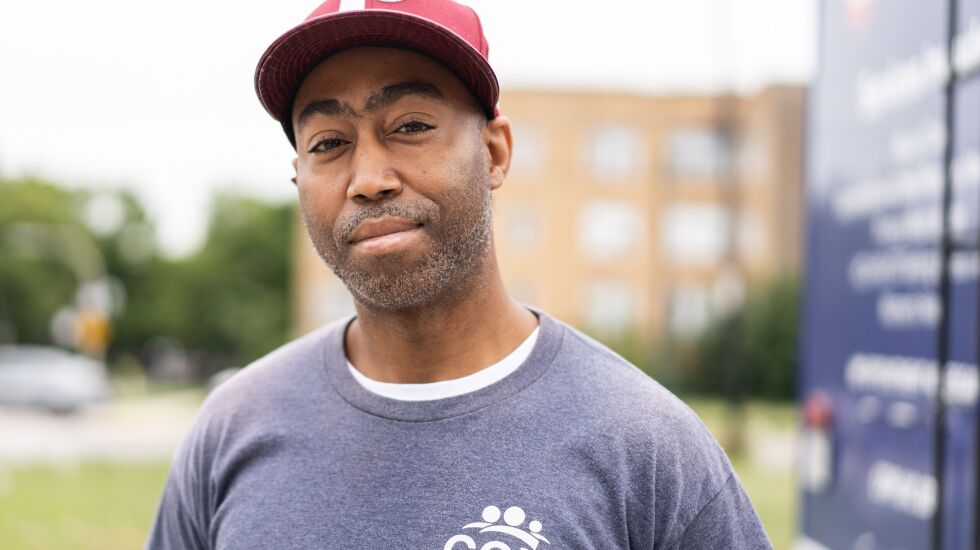
A less-addictive treatment for opioid use won’t help if the people who need it can’t get it.
That’s the reasoning behind a new mobile narcotics treatment now operating on the West Side.
For now, the converted RV parks at the same vacant lot in West Garfield Park, three times a week, though the eventual goal is to go out six days a week, visiting several locations.
It offers a treatment called Suboxone. Available in pharmacies, it is less addictive than methadone because it isn’t as strong, producing less of a high. The treatment could transform narcotics care — if people get it.
“Whether it’s a prescription for Suboxone or insulin, there are some patients that don’t go pick it up. And in that gap, unfortunately, is where overdose and death happens,” said Jennie Jarrett, lead clinical pharmacist and co-director of the University of Illinois at Chicago’s Community Outreach Intervention Projects program.
The UIC center is one of two approved by federal Drug Enforcement Administration’s Chicago field office. It began operating in August. The program is for users who live too far from methadone clinics or from a pharmacy that carries Suboxone.
“The purpose of our bus is to reach people where they are and go to the areas where overdoses are happening and to make it really easy to get on treatment if people are interested, to remove all the barriers,” said Sarah Messmer, a physician and co-director of the UIC program.

It was only in June 2021 that the DEA allowed authorized treatment programs to add mobile units. That required adding a safe and alarm system to prove the drugs would be kept secure, and returning them to a secure facility every night.
“If Suboxone were not a controlled substance, it would be very simple, but it’s been very complicated,” Messmer said.
The centers are the latest tactic for curbing increasing opioid overdose deaths in Chicago.
Last year, 1,447 people died of opioid-related overdoses in Chicago, according to the Cook County medical examiner’s office. That’s up 60% from 2019, 11% from 2020 and the most ever recorded in Chicago.

The converted RV, with the UIC logo on the side, is designed as a primary care clinic. That means it can offer first aid, as well as nonemergency services, such as pregnancy screenings or COVID-19 tests. The main cabin serves as a patient intake room; the rear cabin as an exam room. Staff include a physician, pharmacist, intake specialist, outreach worker and driver.
After spending 13 months getting licensed and training staff, they can now go to users.
“We’re in the community, so we can provide that intervention on the spot,” said Albert Murphy, an outreach worker with the program.

For now, they visit a vacant lot near Pulaski Road and Van Buren Street, which, according to emergency service call data, is at the center of the overdose epidemic. They go Mondays, Wednesdays and Fridays, from 11 a.m. to 3:30 p.m., setting up next to a new safe site for opioid users that also opened this year. The plan is to add locations as they add days.
By being in the neighborhood, they can write and fill Suboxone prescriptions for users hesitant to go to a treatment center.
“There’s those traditional places people go, but then they disengage because they have a bad experience,” Murphy said.

They had set up at the safe site even before being approved as a mobile treatment clinic, because they still could write prescriptions, as well as other services. But now they can fill the prescription, which makes a huge difference.
“When someone already feels terrible, to tell them, ‘OK, now go like 10 blocks away, walk over there, wait an hour or two for them to fill your medicine and then you can pick it up’? It’s not nearly as easy as when you just say, ‘Here’s your medicine,’” Messmer said.
She said most patients live nearby, but word has spread and some patients come from much further. She’s been treating narcotics patients on the West Side for four years, and expects more mobile centers to follow in response to the apparent demand.
“Just goes to show that access to treatment and providers in the community is challenging. It’s wild,” she said, adding: “We have a long way to go.”
Michael Loria is a staff reporter at the Chicago Sun-Times via Report for America, a not-for-profit journalism program that aims to bolster the paper’s coverage of communities on the South and West sides.








